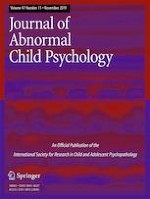18-06-2019
Peer Socialization of Non-Suicidal Self-Injury in Adolescents’ Close Friendships
Gepubliceerd in: Research on Child and Adolescent Psychopathology | Uitgave 11/2019
Log in om toegang te krijgenAbstract
Non-suicidal self-injury (NSSI), or self-harming behavior without intent to die (Nock Current Directions in Psychological Science, 18, 78–83, 2009), is associated with distress and impairment across domains, including increased risk for suicidality (Kiekens et al. Journal of Affective Disorders, 239, 171–179, 2018). In adolescence, prevalence of NSSI is high (Swannell et al. Suicide and Life-threatening Behavior, 44, 273–303, 2014), and peer influence regarding NSSI is thought to be strong (Brechwald and Prinstein Journal of Research on Adolescence, 21, 166–79, 2011). Although concern regarding “clusters” of NSSI has long been documented, peer socialization of NSSI in adolescence is understudied. This paper tests peer influence on NSSI frequency within adolescent friendship dyads. Emotion regulation difficulties and friendship quality were evaluated as factors that may influence susceptibility to peer influence effects. Adolescents (N = 196, M age = 15.68, 69.9% female, 87.6% White) nested within 93 friendship dyads reported on their own NSSI frequency, difficulties in emotion regulation, and friendship quality at three time points spaced 3 months apart. Cross-lagged Actor-Partner Interdependence Models examined peer influence effects over time. Friends’ Time 1 frequency of NSSI uniquely predicted adolescents’ own NSSI frequency over 3 and 6 months, controlling for initial similarity among friends as well as individual risk factors for NSSI. Peer influence effects were strongest in adolescents with higher levels of emotion regulation difficulty but did not vary as a function of friendship quality. Friends’ NSSI frequency is a significant and unique predictor of increases in adolescents’ own NSSI frequency over time. Implications for interventions that leverage the important developmental context of peer relationships are discussed.
